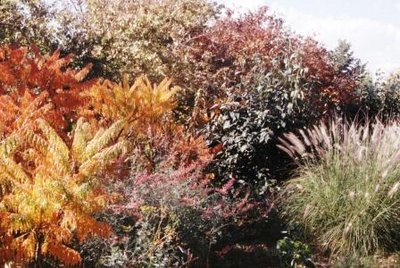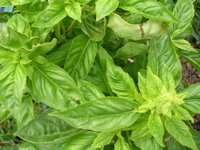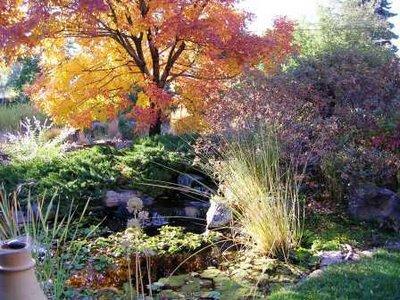
The colors of Autumn are so engaging, so enchanting. I just want to look and look and look - before it's all gone for another year. Fall color is special because it is such a brief sojourn, for one, and also because of the light quality at this time of year. The sun's lower angle really seems to illuminate plant foliage and give it a glow beyond its' fiery colors.
Hope you enjoy this view from my patio...
Attack!

We all have our enemies. Dandelion seed blown in from the empty lot across the street, elm trees "planted" by the birds, aggressively "happy" perennials that we introduced to our gardens ourselves (can you say "yarrow"?) Dealing with these intruders is a fact of garden life---it pays to keep after them throughout the growing season before they get totally out of control and you get totally discouraged. But now, now is the time to hit them with a shot of herbicide! Perennial weeds are moving food reserves down to their roots now, so any systemic herbicide will be pulled down to the roots more efficiently now too. Heh-heh-heh!
Moving Time

Fall is not only a great time for installing new plants, it's also a great time for moving existing favorites. If you have perennials that flower in spring or early summer and need to be divided or moved to a better location, then now is the best time to do it. (Wait to transplant your summer and fall flowering plants and ornamental grasses until next spring.)
One plant, in particular, that should only be moved in the fall is the Peony, Paeonia. Peonies will not flower well is their site has become too shady, or if they were originally planted too deep. Dig up and cut apart the fleshy tuber so that each section has 3-5 eyes or buds and about 6" of root. Replant pieces no more than 1-2" below the soil surface. Peonies grow and bloom best in full sun and are moderately drought tolerant. Plant in deep, rich, well draining soils.
Autumn Joy

Nothing beats the smell of roasted green chiles. One of our favorite Autumn traditions is to stop by a roadside stand, pick out a bushel of chiles, and watch as they're flame roasted in an open tumbler. What will it be this year---poblanos? Big Jim's? Hatch's? Medium, hot or extra hot? This year we choose poblanos, with their dark green, thick flesh and medium heat. The ride home in the car with a big batch of chiles, still steaming in their plastic bag, is pure heaven. We divvy up the chilies into small batches of 3-4, put them in sandwich size freezer bags, and fill up half of our freezer! We'll enjoy them for most of a year in all kinds of delicious dishes.
Treat yourself to some Autumn joy---fresh roasted chiles!
Local Growth
Ever wonder where your plants come from? Colorado has a thriving greenhouse and nursery industry to provide plants that are adapted to our climate and soils. Sure, a lot of our evergreens come from big California or Oregon growers, like Hines and Monrovia, and they provide a good product. But if you shop at a local, independent garden center, you'll find many, many "home grown" plants to choose from.
This week I had the opportunity to visit Boxelder Creek Nurseries in Hudson. This is the state's largest wholesale nursery at 870 acres. There are over one million plants from seedlings to 6" caliper trees in the ground, and thousands more in containers or B&B. They grow over 1,100 varieties (yes!) of deciduous and evergreen trees, shrubs, perennials, grasses, and vines. There's nothing like seeing row after row of beautiful plants to get excited and inspired about gardening.
So shop locally and support your Colorado growers!
Meet . . . Ceratostigma!

Ceratostigma plumbaginoides is the toungue twisting Latin name of Plumbago. This hardy groundcover has stunning blue flowers from August through September, and beyond! The late season blooms are accompanied by brilliant ornage-red foliage for a superior fall color display. Plumbago grows 8"-10" tall and will slowly spread. It's adaptable to most soil types, moderate to dry watering conditions (though not a good choice for super-hot locations), and full sun to shade. What more could you ask for?
Enjoy the View
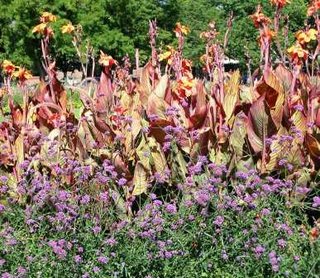
I spent a delightful Sunday morning with my family, strolling through Wash Park. We "ooohed and aaahed" over the wonderful flower displays. The City of Denver does an amazing job every year creating dramatic and showy exhibits with annual bedding plants. They have gotton wise to incorporating colored foliage plants, such as coleus and kale, and ornamental grasses to shore up their flower displays. They also understand the concept of "planting big" - big plants in big areas - for better viewing by passing motorists, bicyclists, runners, skaters, etc. So even if you can't actually stop and smell the roses, keep your eyes open for these lovely and colorful displays---they won't be around to enjoy much longer.
Bloom Inventory
Every few weeks I like to walk through my yard and make note of what all is in bloom. It's a good way to review what I might need to add to my garden center shopping list. That way I'm not quite as likely to get sucked in to buying just what's in bloom at the garden center, but rather what I actually need to add to my garden!
One way to plan for lots of ongoing garden color is to think of plants in terms of their blooming capacity. I classify plants as having 1. Seasonal flowers, 2. Long lasting flowers, 3. Repeat flowers - spontaneous, and 4. Repeat flowers - induced (with a cutting back after the first flowering.) Here are examples from my current bloom inventory:
1. Seasonal--aster, tall Zauschneria, chrysanthemum, goldenrod, tall Sedum.
2. Long lasting--hummingbird mint, Russian sage, plumbago, low Zauschneria, butterfly bush, bluemist spirea, sea lavender, gayfeather.
3. Spontaneous repeat--rose, creeping Potentilla, Centranthus, poppy mallow, Missouri evening primrose, Himalyan border jewel, geranium, blanket flower.
4. Induced repeat--Moonshine yarrow, Salvia, Penstemon, Coreopsis.
What's blooming in your yard today??
Farmer's Market


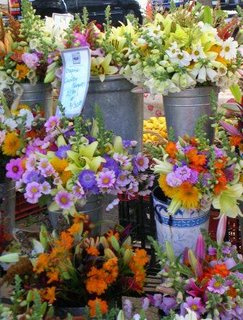
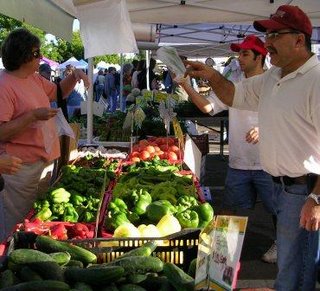
For those of you who did not go to the Cherry Creek Farmer's Market this morning, this is just a sampling of what you missed! No better way to start the weekend, my friends!
Time to Buy Bulbs

It happens every year. Spring rolls around and we fall in love with the beautiful daffodils, tulips, crocus, and snowdrops that seem to be blooming everywhere. And we kick ourselves for not planting some in our own gardens the previous Fall. Head over to your garden center now for the best selection. You will be amazed at the wonderful assortment of both major and minor bulbs --- if you shop early. Don't plant yet though! Store your bulbs in a cool place until the average daily temperatures drop to about 65 degrees. Planting time in our area runs from mid October through November.
I'd love to hear about some of your favorite bulbs, especially those that are long lasting. Just click on "comments" below.
Meet . . . Zauschneria!


Now say that three times as fast as you can! This long blooming perennial is commonly referred to as Hummingbird Trumpet or California Fuchsia, but I prefer to use the botanical name, Zauschneria, for clarity. The tall (3') form, Z. arizonica, is quite drought and heat tolerant, once established. It blooms in my garden from late August into fall. The lower form, Z. garretti, is great in rock gardens or along walkways. It is not quite as drought tolerant, but is much longer blooming---from July through fall. Both of these plants feature hummingbird attracting orange trumpet-shaped flowers. They prefer well drained soil and a good half to full day of sunshine.
The strong orange flower color of Zauschneria calls for companion plants with strong colors as well. Try Missouri evening primrose, globe thistle, 'Moonshine' yarrow or blue avena grass.
Art Imitates Life?

I live a circular life. From my previous post you can see that I use my understanding of the elements and principles of art to create and analyze landscape designs. But from my artwork pictured here, a detail from my fiber piece Summer Sojourn, You can see that my work as a landscape designer informs my art. I spend a lot of time looking at the world around me, and I work hard to really see it. The trick is to learn to then visualize things that may be hidden from view, or better yet, as they could be.
I live a circular life---not that there's anything wrong with that!
Evaluate your Landscape

This is the perfect time of year to evaluate your landscape. Most plants still have all of their foliage and are in full form. Walk your property and take photographs, preferably with a digital camera, of your favorite spaces and/or plant combinations. Take photos of the areas that bug you, too. Sometimes having a two dimensional image to look at allows you to "see" it differently than when you're actually out in the space or even viewing it from a window.
You can use your photos in several different ways. First, compare your favorite landscape areas with those that are a "problem." What are the differences? Look for contrast in plant height, form, or texture---is there enough of it? If you are comparing flower plantings you could also check for bloom density and color combinations.
Next, and here's where those digital images are ideal, convert your photos to black and white. The exclusion of color will allow you to look at your plantings, again, with a totally new eye. Check again for contrast in sizes and shapes of plants, foliage and flowers. Now also look for repetition. By repeating the use of a specific plant, say a shrub or an ornamental grass, throughout the entire landscape, you create a visual thread that ties everything together. Also, by repeating the use of individual plants by planting them together in groups you can create more visual impact and your garden will "read" more clearly.
Finally, use your photos to create a season- by- season (or even month-to-month) record of your landscape. You can then refer to this at any time to plan your next, best, outdoor project!
Yummy Harvest
My husband, Jim, is the Pesto King! He raises basil in containers (much more successful in our sandy soil than in-ground cultivation) every summer and whips up several batches of pesto that he freezes in small batches for year 'round enjoyment. Here's his favorite recipe:
In food processor, combine:
2 cups fresh basil leaves, packed
4 large cloves garlic, peeled
1 cup mixed cocktail nuts (yes!)
Drizzle in 1 cup extra virgin olive oil, on slow speed
Add 1 1/4 cups grated Parmesan cheese in small batches, processing briefly.
Today will be his second harvest of the summer. Hopefully he'll get a bit more in a few weeks---if he remembers to use the floating row covers!
Be Prepared

Today's cool, damp weather is a good reminder that our first frost is not that far away---typically September 30 for the Denver area. While you're out and about this weekend you might want to stop by your local garden center and pick up a floating row cover or frost blanket. These light weight, permeable, reusable throws are just the thing to have on hand to drape over your annual flowers and tender vegetables when frost threatens. There's nothing worse than seeing a great crop of basil or beautiful patio containers turned into mush over night!
Nigel loves Grapes

Nigel, a Vietnamese pot-bellied pig, loves grapes. Not just the fruit, mind you, but all of the other bits and pieces too. You can see from this photo that he has neatly "pruned" the grapes that grow on the vintage wire fence between our two yards.
Grape vines make a wonderfully dense, fast growing screen. They're great on overhead structures, too. My grape is an Eastern Concord (Vitis labrusca 'Eastern Concord'), with deep purple, juicy fruit . I don't make jelly or wine from the fruit, but enjoy eating handfuls and spitting out the seeds as I wander around the garden. I know that there are other varieties of grapes that grow well in Colorado including two whites; 'Himrod' and 'Niagara'. What are you growing? Do you have a recipe that uses the fruit or the leaves to share?
Do it NOW

Reduce your watering! Historical ET (evapotranspiration) data indicate that your bluegrass lawn only needs about 1" of water each week during the beautiful month of September. Now is the time to adjust your automatic sprinkler clock or manual timer so that you apply only the amount of water needed for a healthy lawn. If you would like to learn how to asses your sprinkler system and use it more efficiently go to: http://www.denverwater.org/cons_xeriscape/
conservation/irrigation_bmps.html
Meet . . . Agastache!

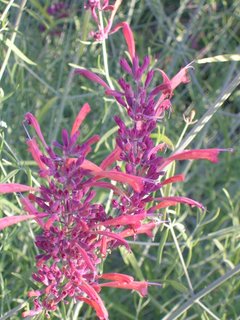
Agastache is a genus of perennials in the mint family that have become very popular for xeriscape gardens --- they like the soil lean and dry! Commonly called hyssop or hummingbird mint (a much prettier name, I think!), these plants range in color from blue to pink to orange. I love the bi-color types, such as Sunset Hummingbird Mint (Agastache rupestris), pictured here. Just last week I planted three more of these beauties in my garden. They have a very long bloom period from mid-summer well into fall. Depending on what variety you choose, the size range is 24" to 48" tall by 18" to 30" wide. They all need full sun and well drained soil, especially in the winter. And, yes, they do attract hummingbirds!
Companion plants for hummingbird mint include English lavender, 'Powis Castle' artemesia, 'May Night' salvia, creeping speedwell, penstemon, and Texas red yucca.
Ag Day

Yesterday my family and I went to the annual Ag Day celebration at Colorado State University in Fort Collins. My husband I are graduates of CSU's College of Agriculture and this is our favorite alumni event of the year. It consists of a huge "tailgate" barbecue and football game. The barbecue is a sampling of all the major foods produced in Colorado: beef, pork, lamb, turkey, corn, potatoes, beans, melons, apples, cheese, milk and more. The horticulture/floriculture industry is also represented - everyone takes home a fall bedding plant (pansies this year)! Hay bales, live music, and gigantic farm equipment set the stage. The "limited" tickets are grabbed up by hundreds of students and alumni for a truly multi-generational affair.
Oh, yea, the game was pretty good, too. Go Rams!
Beginnings

A new month, a new season...a new adventure!
My hope is that in creating this blog/journal I will be able to convey my design and gardening tips, observations and inspirations for your enjoyment and education.
I welcome your comments and suggestions. Blog on!
